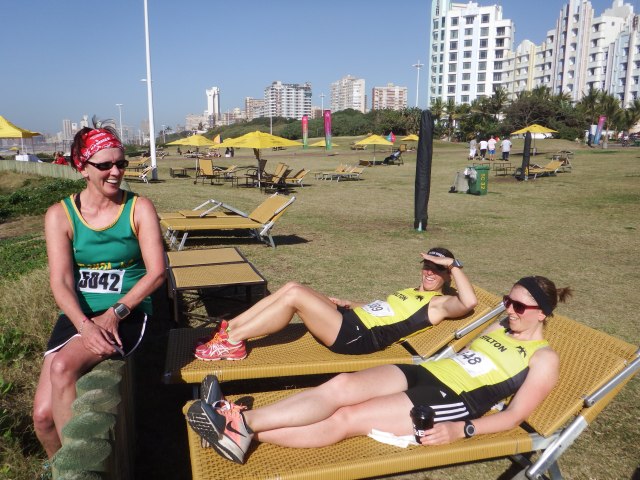
The best part of the 10 km Totalsports Ladies Race in Durban is relaxing with a cappuccino on the beachfront after the race! And what a fabulous race it was! Gorgeous weather, a PB for one of my daughters – and I had new shoes and a new running skirt which I’m sure made me look really fast!
The new shoes were bought on a whim and were a total departure from conventional wisdom (again!). Conventional wisdom says once you have found a shoe that does not give you any hassles, stick with it. I’ve run in Asics Nimbus for over 10 years now with zero hassles and I fully intended to get a new pair of just those.
Before I knew what I was doing I was flirting with a pair of gorgeous turquoise Nike Vomero. They won the day and they are fabulous! I’ve run 27 km in them since I got them on Saturday. I normally wear orthotics in my shoes due to a neuroma on my right foot but have decided to leave them out for a while because these Nikes are just so comfortable as they are. I feel sure they’re going to take me far!
The other thing I’m excited about is that I used the race on Sunday to find my lactate threshold heart rate. I’ve been doing a lot of reading about lactate threshold training and knowing your LTHR is a very useful tool. It is extremely difficult to measure one’s maximum heart rate, unless you have access to a sports laboratory. So when we plug max heart rate and resting heart rate into the available calculators we’re only getting an estimate – and who knows how far out it is? For an obsessive bean-counter like me that’s just not good enough – I want accuracy!
Your lactate threshold heart rate (LTHR) is around 85% of max heart rate. So, take your LTHR, in my case 157, and divide by 0.85. This will give you a more accurate idea of your max heart rate. For me this comes out to 185. I’m 56 so when I use the 220 – age formula (a very common formula) I get a max heart rate of 164. Now that I know my LTHR I can see that this is way too low for me and that I have been working in zones that are set too low.
So this is how I found this magical LTHR – if you are on your own you need to do a 30 minute run at the fastest pace that you can hold for that 30 minutes. Warm up first so that you can go hard from the beginning. After 10 minutes press lap on your watch so that you have a 20 minute lap at the end of the 30 minutes. Your LTHR is the average heart rate for that 20 minutes. I did this for the first half of the race but then subsequently read (Joe Friel) that if you are using a race to measure LTHR, then choose a 60 minute race (10km for me) and use the average heart rate over that 60 minutes. I actually took 66 minutes for my race but I’m not going to be that obsessive!
So there we have it – I’m feeling really upbeat about my running at the moment. I’ve been doing the slow zone 2 thing for 4 months now and I can feel the benefits. I need to do another Z2 test to confirm that I am indeed fitter and faster though and that it is not just an illusion brought on by my snazzy running skirt!